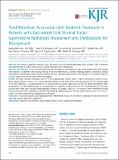| dc.contributor.author | Kim, Kyung Won | en_US |
| dc.contributor.author | Shinagare, Atul B. | en_US |
| dc.contributor.author | Krajewski, Katherine M. | en_US |
| dc.contributor.author | Pyo, Junhee | en_US |
| dc.contributor.author | Tirumani, Sree Harsha | en_US |
| dc.contributor.author | Jagannathan, Jyothi P. | en_US |
| dc.contributor.author | Ramaiya, Nikhil H. | en_US |
| dc.date.accessioned | 2015-04-01T15:30:08Z | |
| dc.date.issued | 2015 | en_US |
| dc.identifier.citation | Kim, Kyung Won, Atul B. Shinagare, Katherine M. Krajewski, Junhee Pyo, Sree Harsha Tirumani, Jyothi P. Jagannathan, and Nikhil H. Ramaiya. 2015. “Fluid Retention Associated with Imatinib Treatment in Patients with Gastrointestinal Stromal Tumor: Quantitative Radiologic Assessment and Implications for Management.” Korean Journal of Radiology 16 (2): 304-313. doi:10.3348/kjr.2015.16.2.304. http://dx.doi.org/10.3348/kjr.2015.16.2.304. | en |
| dc.identifier.issn | 1229-6929 | en |
| dc.identifier.uri | http://nrs.harvard.edu/urn-3:HUL.InstRepos:14351238 | |
| dc.description.abstract | Objective: We aimed to describe radiologic signs and time-course of imatinib-associated fluid retention (FR) in patients with gastrointestinal stromal tumor (GIST), and its implications for management. Materials and Methods In this Institutional Review Board-approved, retrospective study of 403 patients with GIST treated with imatinib, 15 patients with imaging findings of FR were identified by screening radiology reports, followed by manual confirmation. Subcutaneous edema, ascites, pleural effusion, and pericardial effusion were graded on a four-point scale on CT scans; total score was the sum of these four scores. Results: The most common radiologic sign of FR was subcutaneous edema (15/15, 100%), followed by ascites (12/15, 80%), pleural effusion (11/15, 73%), and pericardial effusion (6/15, 40%) at the time of maximum FR. Two distinct types of FR were observed: 1) acute/progressive FR, characterized by acute aggravation of FR and rapid improvement after management, 2) intermittent/steady FR, characterized by occasional or persistent mild FR. Acute/progressive FR always occurred early after drug initiation/dose escalation (median 1.9 month, range 0.3-4.0 months), while intermittent/steady FR occurred at any time. Compared to intermittent/steady FR, acute/progressive FR was severe (median score, 5 vs. 2.5, p = 0.002), and often required drug-cessation/dose-reduction. Conclusion: Two distinct types (acute/progressive and intermittent/steady FR) of imatinib-associated FR are observed and each type requires different management. | en |
| dc.language.iso | en_US | en |
| dc.publisher | The Korean Society of Radiology | en |
| dc.relation.isversionof | doi:10.3348/kjr.2015.16.2.304 | en |
| dc.relation.hasversion | http://www.ncbi.nlm.nih.gov/pmc/articles/PMC4347266/pdf/ | en |
| dash.license | LAA | en_US |
| dc.subject | Imatinib | en |
| dc.subject | Fluid retention | en |
| dc.subject | Subcutaneous edema | en |
| dc.subject | Ascites | en |
| dc.subject | Computed tomography | en |
| dc.title | Fluid Retention Associated with Imatinib Treatment in Patients with Gastrointestinal Stromal Tumor: Quantitative Radiologic Assessment and Implications for Management | en |
| dc.type | Journal Article | en_US |
| dc.description.version | Version of Record | en |
| dc.relation.journal | Korean Journal of Radiology | en |
| dash.depositing.author | Krajewski, Katherine M. | en_US |
| dc.date.available | 2015-04-01T15:30:08Z | |
| dc.identifier.doi | 10.3348/kjr.2015.16.2.304 | * |
| dash.contributor.affiliated | Jagannathan, Jyothi | |
| dash.contributor.affiliated | Krajewski, Katherine | |
| dash.contributor.affiliated | Ramaiya, Nikhil H. | |


